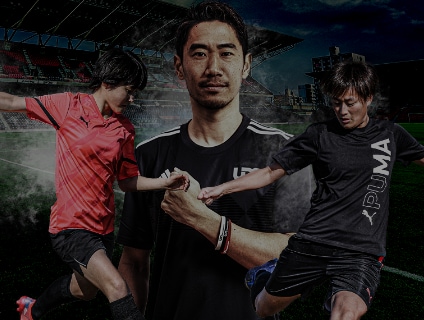
Haruna Tabata and
Shinomi Koyama's

Aiming to “Win a Champions League Title” and “Win a World Championship with Nadeshiko Japan”
Haruna Tabata and Shinomi Koyama of the Cerezo Osaka Sakai Ladies Talk about their Futures and the Future of Women’s Football
We were surrounded by top-level players aiming for the top
In addition to men’s football, Cerezo Osaka is also actively involved in developing Asian and women players. This summer, the men’s U-15 and U-18 teams and the women’s U-18 team all had wins, giving the club its first triple crown in the youth category.
This installment will focus on 20-year-old Haruna Tabata and 17-year-old Shinomi Koyama, who belong to the women’s top team Cerezo Osaka Sakai Ladies (Nadeshiko League Division 1).
When asked how they got into football, Tabata says she tagged along to a practice with her brother who is two years her senior and was playing before she knew it. In a similar vein, Koyama cites the influence of her brother who is three years older. The two players, who seem to be naturals at practicing the “special training” currently being implemented at Cerezo, which breaks age and gender boundaries, speak about their time at the academy, women’s football, and their future prospects.
Haruna Tabata
 Cerezo Osaka Sakai Ladies
Cerezo Osaka Sakai Ladies
Born May 27, 2002. From Osaka. 163 cm / 55 kg. Viento FC Toyono → JFA Academy Sakai → Cerezo Osaka Sakai Girls → Cerezo Osaka Sakai Academy (now Cerezo Osaka Sakai Girls U-15) → Cerezo Osaka Sakai Ladies. A highly-skilled defender who also plays on the front line. Scored 5 goals in the Nadeshiko League in the 2021 season. Played on the U-16, U-19, and U-20 Japan women’s national teams.
Shinomi Koyama
 Cerezo Osaka Sakai Ladies
Cerezo Osaka Sakai Ladies
Born January 31, 2005. From Osaka. 159 cm / 51 kg. Tsukahara Sun Club → Cerezo Osaka Sakai Girls → Cerezo Osaka Sakai Academy (now Cerezo Osaka Sakai Girls U-15) → Cerezo Osaka Sakai Girls → Cerezo Osaka Sakai Ladies. Athletic full-back with high offensive skills. Youngest player (at age 16) to make Nadeshiko League Best Eleven in the 2021 season. Wears #10 for Cerezo and has high tactical and technical skills. Played on the U-16, U-17, and U-20 Japan women’s national teams, and will play for Nadeshiko Japan for the first time in October 2022.

photo: Tabata [left] and Koyama [right]

- Koyama, in elementary school, you played on the Tsukahara Sun Club [in Takatsuki, Osaka] in the same year as Hinata Kawai, who is now the captain of the Cerezo Osaka U-18 team.
- Koyama: Yes. I joined in 4th grade, and Hinata had been on the team the whole time, so there was that difference, but we did play together She was extremely talented, so I had to keep up.
- Tabata, you were on JFA Academy Sakai in junior high. What brought you to join?
- Tabata: I heard about JFA Academy Sakai, and I liked the idea of an environment where I could live in a dorm and focus on football. I lived in a rural area of Osaka, and it was a long commute to any school, so I chose it because I liked the idea of living in dorms.
- Tabata, you joined Cerezo Academy in high school, and Koyama, you joined in junior high. How did you come to join?
- Tabata: When I had to decide my future academic path in my 3rd year of junior high, I thought about continuing on to [JFA Academy] Fukushima, but it was difficult because of my situation. It was then that Coach [Miyo] Okamoto invited me to a practice [of the Cerezo Osaka Sakai Ladies]. I had a lot of fun participating in the practice, so I joined.
- Koyama: I was invited to the elite class when I was in elementary school, and I stayed with Cerezo from there. It was my first all-women’s team, so I wasn’t sure what to expect at first, but the other older players, especially Honoka [Hayashi, now at West Ham United, U.K.], were extremely talented. I wanted to reach their level.
- Did you two first meet when Tabata joined in 2018 during Koyama’s 2nd year of junior high?
- Koyama: Haruna had played against my older brother, so I had heard of her.
- Tabata: Ever since we first met, Maika [Hamano / INAC Kobe Leonessa] and Shinomi were ahead of their peers, so I remember thinking how talented they were.
- Tabata, when you first joined, did you play on the Ladies [top team] or the Girls [U-18 team]?
- Tabata: I went back and forth. At that time, the Girls were in the Challenge League* and the Ladies were in the Nadeshiko League, so I went back and forth between both. Up through junior high, I had only played with players who were the same age as me, so when I came to Cerezo, it was my first time playing with adults of different ages. Everyone was so good, that I remember being overwhelmed at first. I was practicing hard to reach a higher level.
- *Nadeshiko Challenge League: A women’s youth league for high school and club youth teams (U-19, U-17) to strengthen national team and prospective national team players. It does not compete for top league status.
- Koyama, you spent your first two years, which were your 1st and 2nd years of junior high, with the Girls. What do you remember from that time?
- Koyama: I just remember working hard not to lose with Maika (laughs).
- You even competed with the Ladies in 2019 when you were in your 3rd year of junior high.
- Koyama: Some of the girls played with the Ladies, and I wanted to as well. I was so happy to finally have the chance, but everyone was so talented, and I was exposed to lots of stimuli every day.
- You had a lot of role models close by.
- Tabata: There were always inspiring players around me, so I practiced with the determination to not lose to those above me.
- Koyama: I was surrounded by players that were aiming to become top-level, that I would look at and think, “These are the ones who are going to make the team,” and they are on Nadeshiko Japan now. There was a lot to learn from them both on and off the pitch. The same goes for preparation for practice, and even during practice, we were told when we made bad plays and praised when we made good ones. It was easy to see where my strengths and weaknesses were. I learned a lot.
An open environment with no hierarchy
The two players continue to grow, inspired by their seniors at the Nadeshiko Japan level, such as Honoka Hayashi (West Ham United, U.K.), Nanami Kitamura (Nippon TV Tokyo Verdy Beleza), and Saori Takarada (Linköpings FC, Sweden).

- What you have been saying reinforces this, but Cerezo Academy seems to be an environment where the men’s and women’s teams get along well, and there is open communication between seniors and juniors. What do you think is the best thing about the Cerezo Osaka Sakai Ladies?
- Tabata: There’s truly no hierarchy. Everyone is full of energy both on and off the pitch, and we simply have fun together. That gives us room to play football in a relaxed and easy manner.
- Koyama: Unlike other teams who have players that are 10 years apart, we’re closer in age, so it’s easier to see what we should be aiming for. It feels like [the level of senior players] is just beyond reach, but we can catch up if we work hard. I think having them as role models is what’s great about the club.
- Are there any leaders in particular that influenced you?
- Tabata: For me, it was Coach Kaori Taneda, who was my coach in my 1st year of junior high [at JFA Academy Sakai] and currently the head coach for Speranza Osaka-Takatsuki. She inspired me greatly both on and off the pitch. Since we were living in dorms, she hammered into us what we needed to know to become better players both while playing and while off the pitch. I think I’ve been learning about football at a higher level since coming to Cerezo, from both Coach Okamoto and from our current coach, Coach [Tomoya] Takehana.
- Koyama: Personally, I was influenced by everyone, rather than by any particular person. I feel like I’m being taught what I need to know at any given moment.
- Are there any particular memorable matches in your football life so far?
- Tabata: The [U-20] World Cup is the most memorable part of my football life so far. It was particularly special because of the amount of effort we put into getting there.
- Koyama: It also sticks out as an incredibly impactful game for me.
Aiming to reaffirm their world with the World Cup
The U-20 Women’s World Cup was held in Costa Rica in August. Aiming for consecutive wins, the Japanese U-20 women’s national team defeated the Netherlands, Ghana, and the U.S. in the Group Stage to take the top spot. In the final tournament, the team beat France in a penalty shootout in the quarterfinals and won against Brazil in the semifinals. However, they lost to Spain in the finals and finished as runners-up.
Tabata and Koyama started as defenders in all six of these games.

- You played against the best countries in the world in the U-20 World Cup.
- Tabata: The World Cup was the stage that we had been aiming for, so we went into the competition with very strong passion. As little as a month before the cup started, I wasn’t even in the starting lineup at Cerezo and things were not going that well, so there were times when I couldn’t even imagine myself playing in the World Cup. However, I kept trying my best even when things didn’t go well, with my goal of a championship win in my mind, and I think that contributed to me being a starter in games.
- You both scored goals in the Group Stage 3rd Sec. game against the U.S.
- Tabata: Shinomi was the first to score. As a member of Cerezo, when she scored, and it made me determined to keep up with her and score as well. I’m glad I was able to score.
- Koyama, did playing in the cup reaffirm any feelings for you?
- Koyama: Before the cup, my position [at Cerezo Osaka] was different. A different position requires different things, so that deviation was quite stressful. However, going forward, in order to reach a higher level, I think it’s necessary to see how I can fit myself into that, and as the coach told me, I just have to do it.
- As part of that, I don’t think I would have scored in the match against the U.S. if I hadn’t been playing as a forward at Cerezo. I had been practicing that form for a long time. In that sense, while the deviation was stressful at first, I think it ultimately contributed to achieving results.
- You never know where you’ll be placed on the national team. You beat France in the quarterfinals in a last-minute penalty shootout, then defeated Brazil in the semifinals, then played against Spain in the finals. The entire crowd was cheering for Japan.
- Tabata: It was our first time playing in front of 30,000 people. The cheers were incredible, and it was an amazing experience competing in the finals in that environment.
- Koyama: When we beat France, we got that much closer to a championship win, and while I wouldn’t say it caused me to let my guard down, it made me think, “We could win this,” which I regret. However, as far as showing Japan’s uniqueness, I think we were able to do that through the cup. We became a team that was cheered on. I didn’t think football could move people that much. The crowd grew with each game, and it was a lot of fun.
- Tabata: A lot of people were flying our opponents’ flag before the game started, but as we won games, more and more people started supporting Japan and flying the Japanese flag. I really felt that this is what it means to move people.
- Even at the awards ceremony, Maika Hamano, who was chosen as the tournament MVP, got lots of love from the Brazilian players. She seems to have moved even the opposing team. Koyama, having played with her for a long time, did it feel special to be able to play together on such a big stage?
- Koyama: It was so much fun. When Maika plays well, it makes me feel like I need to play well, too. It had been about a year since we last played a formal game together, and Maika led the team with her unique playing, which brought out my own courage and was a lot of fun.
- One of the themes of this series is “setting sights on playing internationally.” Your seniors Honoka Hayashi and Saori Takarada have built careers with Nadeshiko Japan and overseas.
- Tabata: They both have successful international careers, and I would like to play in Europe as well. I think playing for Nadeshiko Japan would also open up the opportunity for me to play internationally, so that’s my constant goal. I like Spain, so I would like to go to Spain.
- Koyama: I’ve always aimed to go international as well. I would like to play in the [England] Premier League like Honoka. I’ve been watching her for a long time, and I can't wait to get to that stage myself.
- Tabata: After the U-20 World Cup ended, Saori contacted me and congratulated me on the second-place win, and we spoke a little bit. She said that second place was something to be proud of, and I told her that I would follow in her footsteps.
- Koyama: I hear from Honoka frequently. She wished me luck before the World Cup. She also gets in touch when things aren’t going well with the team.
So far, we have followed;
now, we will lead as role models
Tabata is 20 and Koyama is 17. After following in their Cerezo seniors’ footsteps and facing the world in the World Cup, they must now reexamine their own futures. The team’s membership in the Japan Women's Empowerment Professional Football League (WE League) has also been decided. In addition, Koyama has received her first invitation to play with Nadeshiko Japan for the international friendly match and MS&AD Cup in October.
The women’s words reflect their strong passion for bringing more excitement to Japanese women’s football itself by personally achieving results.

- What serves as your driving force as players and motivates you in your everyday playing?
- Tabata: I want to repay the leaders who have supported me and taught me by showing them that I’m successful. I also play football to achieve my own dreams.
- Koyama: I think the heart is the driving force for all humans. There’s the desire to not be defeated, to reach the top, and a feeling of gratitude. Wanting to make my family proud is the biggest one.
- The Cerezo Osaka Sakai Ladies will join the WE League starting in the 2023-24 season. Has this increased your motivation?
- Tabata: I have always wanted to play in the WE League, so I have a strong desire to achieve results from the very first year.
- Koyama: Results are everything in the pros. I’m not the strongest mentally, but I have grown in these past two years. I want to further develop my mentality as a pro. We have to get results in the WE League in order to succeed internationally. There are more than six months [until we join], so I’ll do my best.
- As academy alumni, how do you want to be seen by your juniors?
- Tabata: I want to achieve results internationally and become someone they can look up to.
- Koyama: I have been following in others’ footsteps so far, but going forward, I want to become a player that sets an example that younger players can follow, including behavior-wise.
- Lastly, what are your future prospects as football players?
- Tabata: I like Barcelona, so my goal is to play for Barcelona and win a Champions League title. It’s a big dream, but I want to work hard toward my goal and rewrite history.
- Koyama: When Homare Sawa was playing was a key time for Japanese women’s football, and I want us to be the next role models in Japanese women’s football. Also, my goal is to have a successful international career and win a world championship with Nadeshiko Japan, so I want to keep working hard to make that dream come true.

Cerezo Osaka, the power of the academy
 for the future
for the future
Cerezo Osaka Academy aims to develop world-class player. From Cerezo Osaka to the world.
"We want many beautiful flowers to bloom in the future."
We approach the driving force for such a future.


Athlete's

Why do top athletes keep challenging?
We approach the driving force of top athletes who continue to challenge.

















